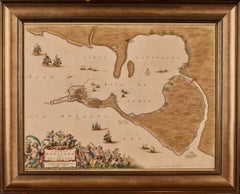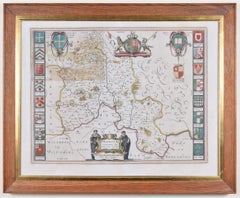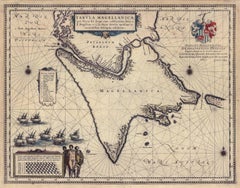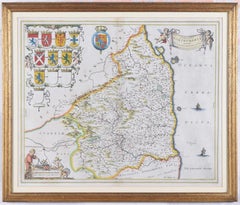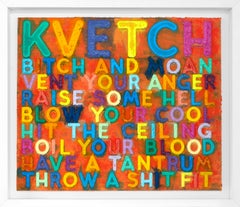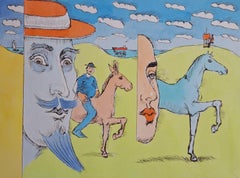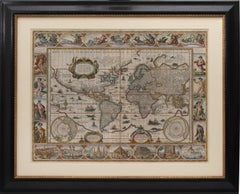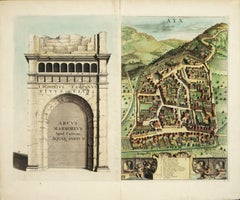Joan (Johannes) Blaeu Art
to
1
3
1
Overall Width
to
Overall Height
to
4
1
4
2
2
2
1
1
1
4
6
10,083
2,778
1,380
1,375
3
2
2
Artist: Joan (Johannes) Blaeu
Cadiz Island: A Framed 17th Century Hand-colored Map from Blaeu's Atlas Major
By Joan (Johannes) Blaeu
Located in Alamo, CA
This is a 17th century hand-colored map entitled "Insula Gaditana Isla de Cadiz" from Johannes (Joan) Blaeu's Atlas Maior, published in Amsterdam in 1662.
The map provides an excellent plan of Cadiz Island on the southwest coast of Spain, with its harbor, fortifications, agricultural fields and several surrounding salt processing areas. Numerous sailing ships of various sizes are included in and around the harbor and bay, including five large sailing ships, as well as twenty-four smaller ships. There is a small compass rose overlying the bay. The bridge to the mainland from the island is shown on the right. There is an extremely ornate and colorful title cartouche in the lower left, with its mythological figures reminiscent of Raphael’s Galatea fresco at the Villa Farnesina in Rome. The vibrant colors are vividly preserved. The master colorist tried to emulate a painting by using various tones to create a three-dimensional effect.
Blaeu's name is present in the plate in the lower right. Blaeu stated in his description of Cadiz: “The main wealth of the islanders consists of salt, which they harvest, and
the tuna fisheries.”
This 17th century hand-colored map is framed in an ornate, partially textured bronze-colored wood frame and glazed with UV protected conservation glass. There is a vertical center fold, as issued. There is a faint crease in the lower right and faint color offset on the left from the right side of the map, resulting from having been in an atlas for hundreds of years. Small foci of paint are present in the upper portion of the left margin and in the left corner margin. The map is otherwise in very good condition.
Due in large part to their powerful trade empire, the Dutch became known for cartography in the seventeenth century. This period is considered the Golden Age of Dutch cartography. Their publishing houses produced the highest quality work in Europe, particularly those maps and charts of foreign lands, and Dutch map-making set the bar for cartographic accuracy and artistry into the early-eighteenth century. Some of the most well-known cartographers worked in Amsterdam during this period. Perhaps the most famous of these was the Blaeu family. Willem Janszoon Blaeu, set up shop in Amsterdam. His son, Johannes (Joan), succeeded him upon his death in 1638, continuing in his father’s position as Hydrographer to the Dutch East India Company and selling maps to the public. The Blaeu map presses, located near Amsterdam’s Dam Square...
Category
Mid-17th Century Old Masters Joan (Johannes) Blaeu Art
Materials
Engraving
Map of Oxfordshire by Joan Blaeu with college crests
By Joan (Johannes) Blaeu
Located in London, GB
To see our other original maps, scroll down to "More from this Seller" and below it click on "See all from this Seller" - or send us a message if you cannot find the poster you want....
Category
1660s Joan (Johannes) Blaeu Art
Materials
Engraving
Tabula Magellanica, qua Tierra del fuego, cum celeberrimis fretis a F. Magellano
By Joan (Johannes) Blaeu
Located in New York, NY
This mid 17th-century map was published by Guiljelmum Blaeu in Amsterdam. The engraved map is 16 1/8 x 21" (41 x 53.1 cm) with beautiful original hand color. Tabula Magellanica is a highly decorative map of the southern tip of South America, including Tierra del Fuego...
Category
Mid-17th Century Other Art Style Joan (Johannes) Blaeu Art
Materials
Engraving
Map of Northumberland by Joan Blaeu
By Joan (Johannes) Blaeu
Located in London, GB
To see our other original maps, scroll down to "More from this Seller" and below it click on "See all from this Seller" - or send us a message if you cannot find the poster you want....
Category
1660s Joan (Johannes) Blaeu Art
Materials
Engraving
Related Items
"Kvetch" monoprint in oil with collage, engraving and embossment by Mel Bochner
By Mel Bochner
Located in Boca Raton, FL
"Kvetch" monoprint in oil with collage, engraving and embossment on handmade paper by artist Mel Bochner from Two Palms Publishing. Signed and dated Bochner 2021 lower right recto. I...
Category
2010s Contemporary Joan (Johannes) Blaeu Art
Materials
Oil, Handmade Paper, Engraving
$48,000
H 29.25 in W 33.75 in
Painter painting Don Quixote - Figurative Drypoint Print, Colorful, Polish Art
By Czeslaw Tumielewicz
Located in Warsaw, PL
Colorful figurative drypoint print by Polish artist Czeslaw Tumielewicz. Subject for this artwork comes from Miguel de Cervantes' book. The print is signed, it comes from edition lim...
Category
Early 2000s Contemporary Joan (Johannes) Blaeu Art
Materials
Paper, Drypoint, Watercolor
$336 Sale Price
20% Off
H 8.27 in W 11.03 in
Iris Lurida. Iris Brune.
By Pierre-Joseph Redouté
Located in London, GB
REDOUTE, Pierre-Joseph.
Iris Lurida. Iris Brune.
Paris, Chez L’Auteur, 1802-16
The highest peak of Redoute's artistic and botanical achievement... Among the most important monum...
Category
Mid-19th Century Naturalistic Joan (Johannes) Blaeu Art
Materials
Paper, Engraving
Restaurant in Mott Street
By Charles Frederick William Mielatz
Located in New Orleans, LA
The image depicts a restaurant on New York's Mott Street with ornamental iron work on the balconies. There are six figures in the scene in various stages of contrast. Mott Street is considered the unofficial Main Street of New York's Chinatown. Ella Fitzgerald sang it best: “And tell me what street compares with Mott Street in July? Sweet pushcarts gently gliding by.”
CFW Mielatz was an early influence on the drypoints and etchings of Martin Lewis. This piece was created in 1906 and it is signed in pencil. It is part of the collection of New York's Metropolitan Museum of Art
C.F.W. Mielatz
American, 1860-1919
Born in Bredding, Germany in 1864, Mielatz emigrated to the United States as a young boy and studied at the Chicago School of Design. Mostly self-taught, his first prints were large New England landscapes reminiscent of the painter-etcher school of American Art. Around 1890 he started to produce prints of New York City and by the time of his death, the number totaled over ninety images. He was a master technician in the field of etching, reworking many of his plates to get the exact feeling he was seeking. Mielatz was a member of the New York Etching...
Category
Early 20th Century American Modern Joan (Johannes) Blaeu Art
Materials
Drypoint, Etching
$412 Sale Price
25% Off
H 9.88 in W 6.25 in
London Bridge, C18th English aquatint
Located in Melbourne, Victoria
'London Bridge'
Aquatint by JC Stadler after J Farmington.
Published c1795 for Boydell's 'History of the River Thames'. Joseph Constantine Stadler (fl London, 1780-1822) was an eng...
Category
Late 18th Century Naturalistic Joan (Johannes) Blaeu Art
Materials
Engraving
Plan of the Park, Garden and Plantations of Goodwood, 18th century engraving
By Colen Campbell
Located in Melbourne, Victoria
Plan of the Park, Garden and Plantations of Goodwood in Sussex the Seat of his Grace the Duke of Richmond and Lenox &c
Copper-line engraving with later hand-colouring by Hendrik Hul...
Category
18th Century English School Joan (Johannes) Blaeu Art
Materials
Engraving
$450
H 21.26 in W 27.56 in
Siena [Large Version] - British Modernism Italian Architecture Siena
By Ben Nicholson
Located in London, GB
This original etching and drypoint is hand signed in pencil by the artist "Nicholson" at the lower left margin and dated “65” next to the signature.
It is also hand numbered from the...
Category
1960s Modern Joan (Johannes) Blaeu Art
Materials
Drypoint, Etching
$3,500
H 16.93 in W 14.77 in
Baroque 17th century German fountain design engraving print by Boeckler
By Georg Andreas Böckler
Located in Melbourne, Victoria
17th century German fountain design
Copper-line engraving, published in 1664 in Nuremberg. From 'Architectura Curiosa Nova' by George Andreas Beckley (...
Category
Mid-17th Century Baroque Joan (Johannes) Blaeu Art
Materials
Engraving, Etching
Falcon Crag, Lake District scenery C19th English aquatint
Located in Melbourne, Victoria
'Falcon Crag'
Aquatint by William Green, 1804
William Green of Ambleside was a Lake District draughtsman, soft ground etcher and aquatint engraver of ...
Category
Early 19th Century Naturalistic Joan (Johannes) Blaeu Art
Materials
Engraving, Aquatint
The Lighthouse - Mandela, Former South African President, Signed, Robben Island
By Nelson Mandela
Located in Knowle Lane, Cranleigh
Nelson Mandela, The Lighthouse, Signed Limited Edition Lithograph
Many people are unaware that Nelson Mandela turned his hand to art in his 80's as a way of leaving a legacy for his family. He spent time with an art tutor and learnt to draw. In 2002, when creating the The Lighthouse print...
Category
Early 2000s Contemporary Joan (Johannes) Blaeu Art
Materials
Lithograph
$12,405
H 19.69 in W 22.05 in D 1.58 in
Don Quixote and apparition - Figurative Drypoint Print, Colorful, Polish Art
By Czeslaw Tumielewicz
Located in Warsaw, PL
Subject for this artwork comes from Miguel de Cervantes' book.
CZESLAW TUMIELEWICZ (b. 1942)
In 1968, he studied at the Architecture faculty of Gdank, before continuing his course a...
Category
Early 2000s Contemporary Joan (Johannes) Blaeu Art
Materials
Paper, Watercolor, Drypoint
Baroque 17th century German fountain design engraving print by Boeckler
By Georg Andreas Böckler
Located in Melbourne, Victoria
Baroque 17th century German fountain design
Copper-line engraving, published in 1664 in Nuremberg. From 'Architectura Curiosa Nova' by George Andreas B...
Category
Mid-17th Century Baroque Joan (Johannes) Blaeu Art
Materials
Engraving, Etching
Previously Available Items
Set of World & Four Continents
By Joan (Johannes) Blaeu
Located in London, GB
BLAEU, Johannes.
[Set of World & Four Continents from the 'Atlas Major']
Nova et Accuratissima Totius Terrarum Orbis Tabula; Americæ nova Tabula; Asia noviter delineata; Africæ nova descriptio; Europa recens descripta.
Amsterdam, n.d. [c. 1650].
Set of 5 hand-coloured double-page engraved maps, centre fold as issued, with cartouches for the titles and dedication, Latin text on verso; sheet size: 49 x 60 cm. Framed and glazed, overall size: 61 x 75 x 2 cm.
A fine set of five maps from the most expensive book published in the 17th century, an eleven-volume atlas containing 593 hand-coloured maps. The highly decorative borders have allegorical figures of the known planets along the top, lateral borders of the Four Elements and the Four Seasons, and the Seven Wonders of the Ancient World along the bottom. Each of the continents has lateral borders of native dress and nine city prospects along the top.
Blaeu's set of the World & Continents are perhaps the most decorative and cartographically accurate of all sets published in the 17th Century. Blaeu's work set the standard for other map makers during the Golden Age of Cartography, characterised by fine engraving, high quality paper and fine geographical detail. His map of the world is one of the earliest maps to utilize the Mercator Projection, which allowed mariners in the open sea to make practical use of maps. The map of the World is embellished with allegorical representations of the 4 seasons and 4 elements in the side panels, the 7 wonders of the Ancient World at the bottom and representations of the Classical Planets, moon and sun at the top. The maps of the 4 continents...
Category
17th Century Joan (Johannes) Blaeu Art
Materials
Watercolor, Engraving
AYX Map of Aix en Provence, France by J. Blaeu 17th c.
By Joan (Johannes) Blaeu
Located in Paonia, CO
Detailed plan of Aix en Provence, in France. This print is a hand -colored double sheet engraving by the famous cartographer Joan (Johannes) Blaeu ( 1596 - 1673 ). The left side ...
Category
Late 17th Century Other Art Style Joan (Johannes) Blaeu Art
Materials
Engraving
Joan (johannes) Blaeu art for sale on 1stDibs.
Find a wide variety of authentic Joan (Johannes) Blaeu art available for sale on 1stDibs. You can also browse by medium to find art by Joan (Johannes) Blaeu in engraving, paint, watercolor and more. Much of the original work by this artist or collective was created during the 18th century and earlier and is mostly associated with the Old Masters style. Not every interior allows for large Joan (Johannes) Blaeu art, so small editions measuring 20 inches across are available. Customers who are interested in this artist might also find the work of Stefano Della Bella, Karel Dujardin, and Gerard Mercator. Joan (Johannes) Blaeu art prices can differ depending upon medium, time period and other attributes. On 1stDibs, the price for these items starts at $956 and tops out at $37,587, while the average work can sell for $1,150.
